climate control FORD EXPEDITION 2021 Owners Manual
[x] Cancel search | Manufacturer: FORD, Model Year: 2021, Model line: EXPEDITION, Model: FORD EXPEDITION 2021Pages: 574, PDF Size: 8.33 MB
Page 6 of 574
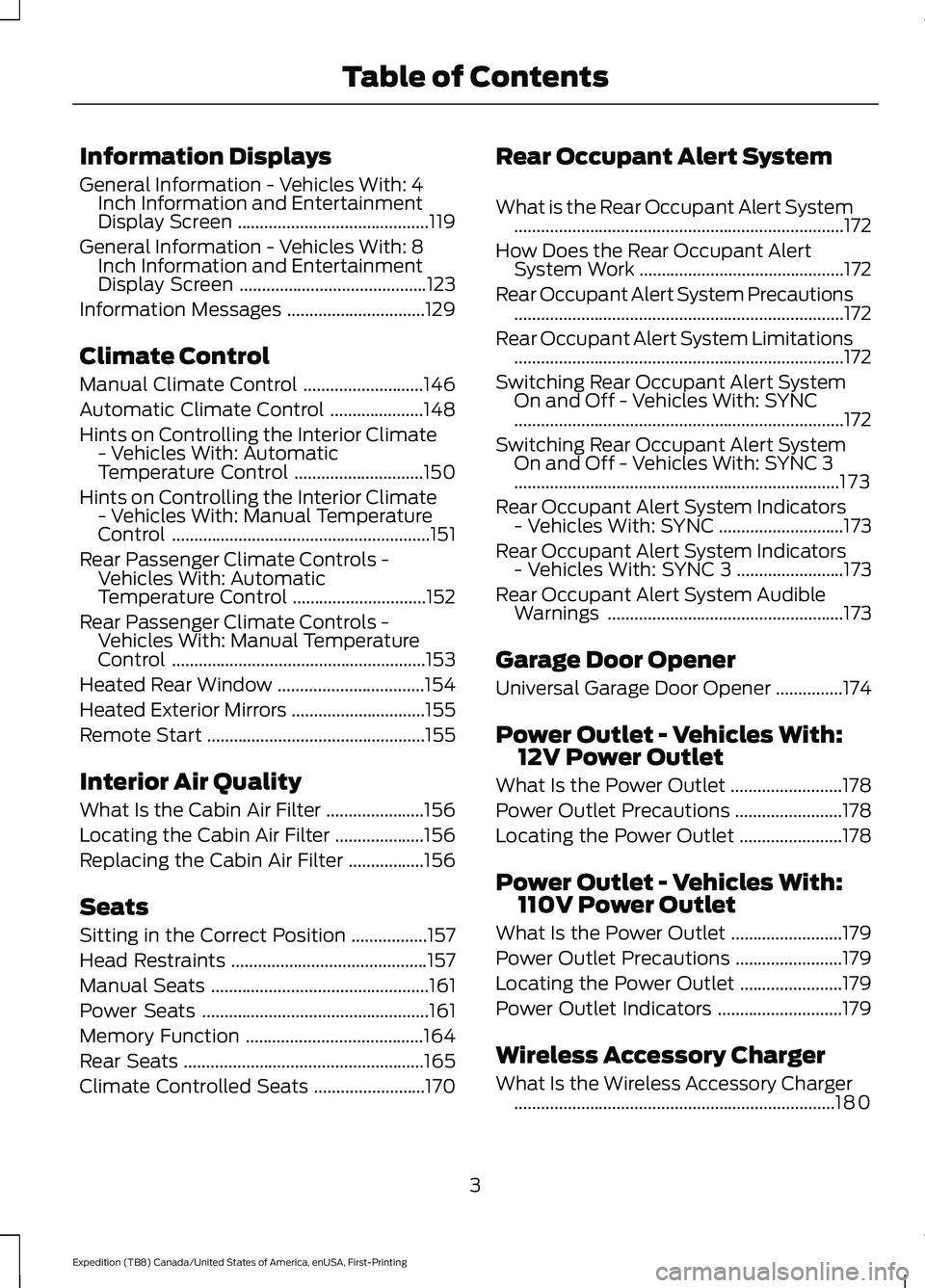
Information Displays
General Information - Vehicles With: 4
Inch Information and Entertainment
Display Screen ...........................................119
General Information - Vehicles With: 8 Inch Information and Entertainment
Display Screen ..........................................
123
Information Messages ...............................
129
Climate Control
Manual Climate Control ...........................
146
Automatic Climate Control .....................
148
Hints on Controlling the Interior Climate - Vehicles With: Automatic
Temperature Control .............................
150
Hints on Controlling the Interior Climate - Vehicles With: Manual Temperature
Control ..........................................................
151
Rear Passenger Climate Controls - Vehicles With: Automatic
Temperature Control ..............................
152
Rear Passenger Climate Controls - Vehicles With: Manual Temperature
Control .........................................................
153
Heated Rear Window .................................
154
Heated Exterior Mirrors ..............................
155
Remote Start .................................................
155
Interior Air Quality
What Is the Cabin Air Filter ......................
156
Locating the Cabin Air Filter ....................
156
Replacing the Cabin Air Filter .................
156
Seats
Sitting in the Correct Position .................
157
Head Restraints ............................................
157
Manual Seats .................................................
161
Power Seats ...................................................
161
Memory Function ........................................
164
Rear Seats ......................................................
165
Climate Controlled Seats .........................
170Rear Occupant Alert System
What is the Rear Occupant Alert System
........................................................................\
..
172
How Does the Rear Occupant Alert System Work ..............................................
172
Rear Occupant Alert System Precautions ........................................................................\
..
172
Rear Occupant Alert System Limitations ........................................................................\
..
172
Switching Rear Occupant Alert System On and Off - Vehicles With: SYNC
........................................................................\
..
172
Switching Rear Occupant Alert System On and Off - Vehicles With: SYNC 3
........................................................................\
.
173
Rear Occupant Alert System Indicators - Vehicles With: SYNC ............................
173
Rear Occupant Alert System Indicators - Vehicles With: SYNC 3 ........................
173
Rear Occupant Alert System Audible Warnings .....................................................
173
Garage Door Opener
Universal Garage Door Opener ...............
174
Power Outlet - Vehicles With: 12V Power Outlet
What Is the Power Outlet .........................
178
Power Outlet Precautions ........................
178
Locating the Power Outlet .......................
178
Power Outlet - Vehicles With: 110V Power Outlet
What Is the Power Outlet .........................
179
Power Outlet Precautions ........................
179
Locating the Power Outlet .......................
179
Power Outlet Indicators ............................
179
Wireless Accessory Charger
What Is the Wireless Accessory Charger ........................................................................\
180
3
Expedition (TB8) Canada/United States of America, enUSA, First-Printing Table of Contents
Page 16 of 574
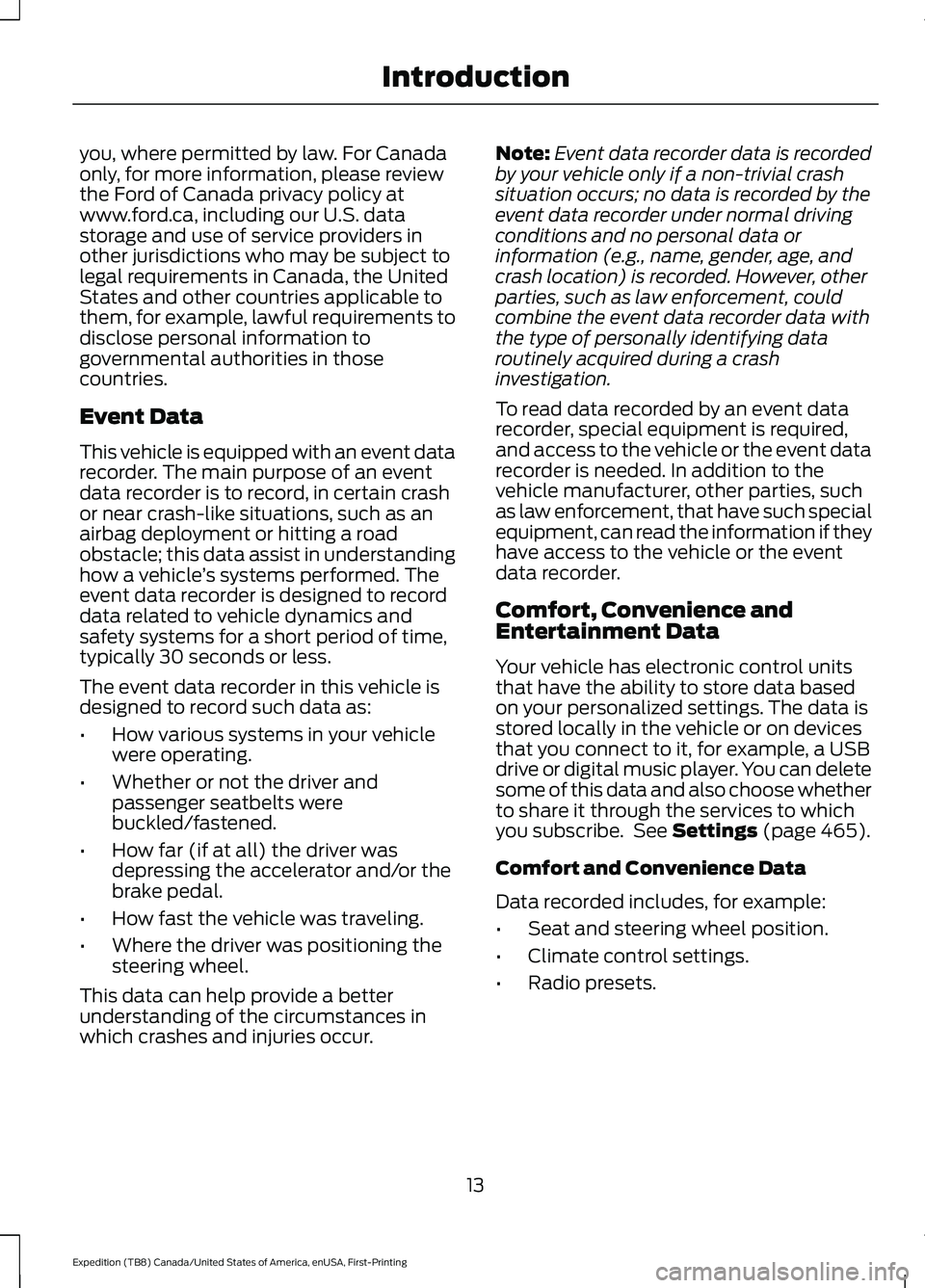
you, where permitted by law. For Canada
only, for more information, please review
the Ford of Canada privacy policy at
www.ford.ca, including our U.S. data
storage and use of service providers in
other jurisdictions who may be subject to
legal requirements in Canada, the United
States and other countries applicable to
them, for example, lawful requirements to
disclose personal information to
governmental authorities in those
countries.
Event Data
This vehicle is equipped with an event data
recorder. The main purpose of an event
data recorder is to record, in certain crash
or near crash-like situations, such as an
airbag deployment or hitting a road
obstacle; this data assist in understanding
how a vehicle
’s systems performed. The
event data recorder is designed to record
data related to vehicle dynamics and
safety systems for a short period of time,
typically 30 seconds or less.
The event data recorder in this vehicle is
designed to record such data as:
• How various systems in your vehicle
were operating.
• Whether or not the driver and
passenger seatbelts were
buckled/fastened.
• How far (if at all) the driver was
depressing the accelerator and/or the
brake pedal.
• How fast the vehicle was traveling.
• Where the driver was positioning the
steering wheel.
This data can help provide a better
understanding of the circumstances in
which crashes and injuries occur. Note:
Event data recorder data is recorded
by your vehicle only if a non-trivial crash
situation occurs; no data is recorded by the
event data recorder under normal driving
conditions and no personal data or
information (e.g., name, gender, age, and
crash location) is recorded. However, other
parties, such as law enforcement, could
combine the event data recorder data with
the type of personally identifying data
routinely acquired during a crash
investigation.
To read data recorded by an event data
recorder, special equipment is required,
and access to the vehicle or the event data
recorder is needed. In addition to the
vehicle manufacturer, other parties, such
as law enforcement, that have such special
equipment, can read the information if they
have access to the vehicle or the event
data recorder.
Comfort, Convenience and
Entertainment Data
Your vehicle has electronic control units
that have the ability to store data based
on your personalized settings. The data is
stored locally in the vehicle or on devices
that you connect to it, for example, a USB
drive or digital music player. You can delete
some of this data and also choose whether
to share it through the services to which
you subscribe. See Settings (page 465).
Comfort and Convenience Data
Data recorded includes, for example:
• Seat and steering wheel position.
• Climate control settings.
• Radio presets.
13
Expedition (TB8) Canada/United States of America, enUSA, First-Printing Introduction
Page 23 of 574
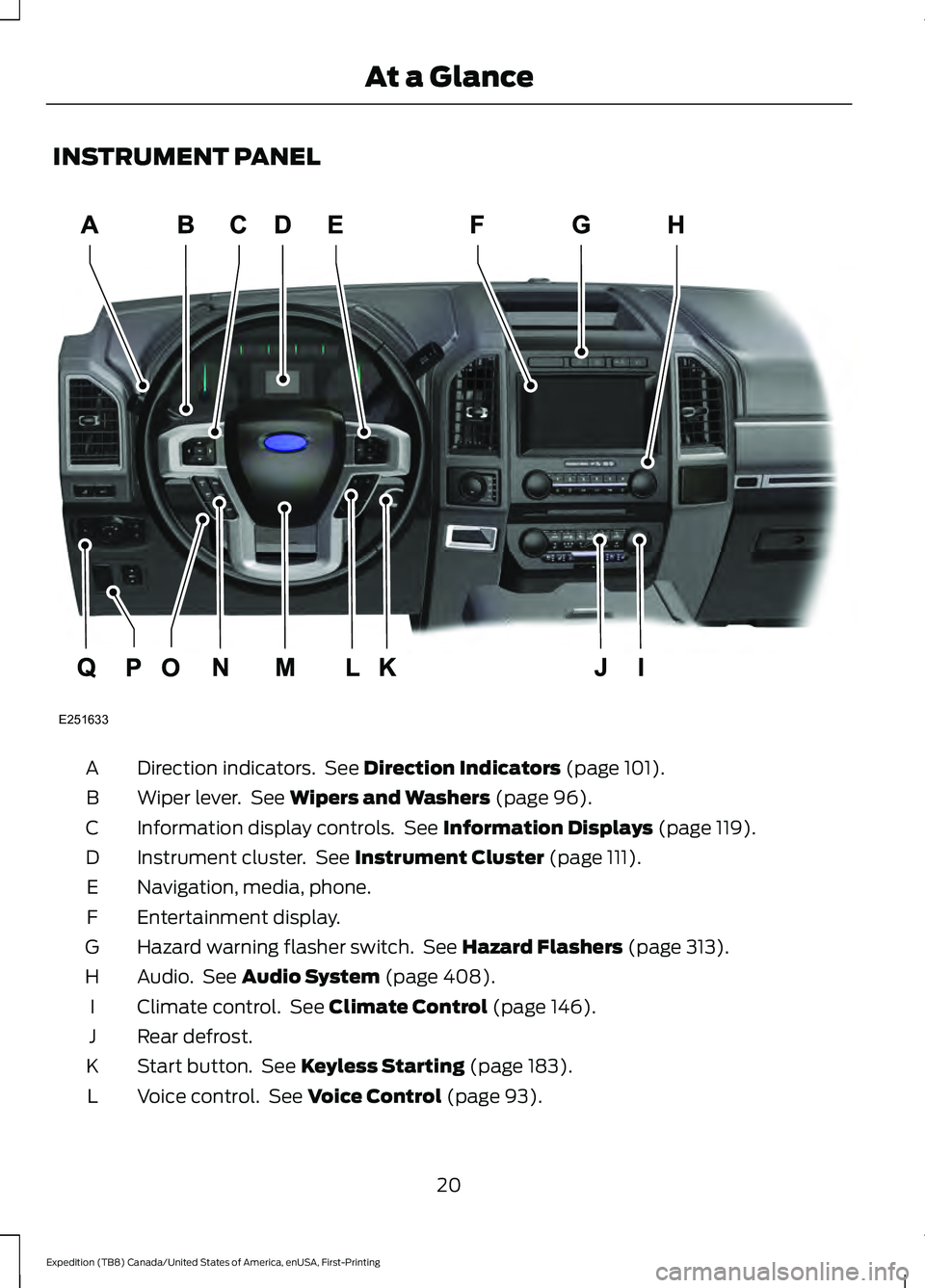
INSTRUMENT PANEL
Direction indicators. See Direction Indicators (page 101).
A
Wiper lever. See
Wipers and Washers (page 96).
B
Information display controls. See
Information Displays (page 119).
C
Instrument cluster. See
Instrument Cluster (page 111).
D
Navigation, media, phone.
E
Entertainment display.
F
Hazard warning flasher switch. See
Hazard Flashers (page 313).
G
Audio. See
Audio System (page 408).
H
Climate control. See
Climate Control (page 146).
I
Rear defrost.
J
Start button. See
Keyless Starting (page 183).
K
Voice control. See
Voice Control (page 93).
L
20
Expedition (TB8) Canada/United States of America, enUSA, First-Printing At a GlanceE251633
Page 68 of 574
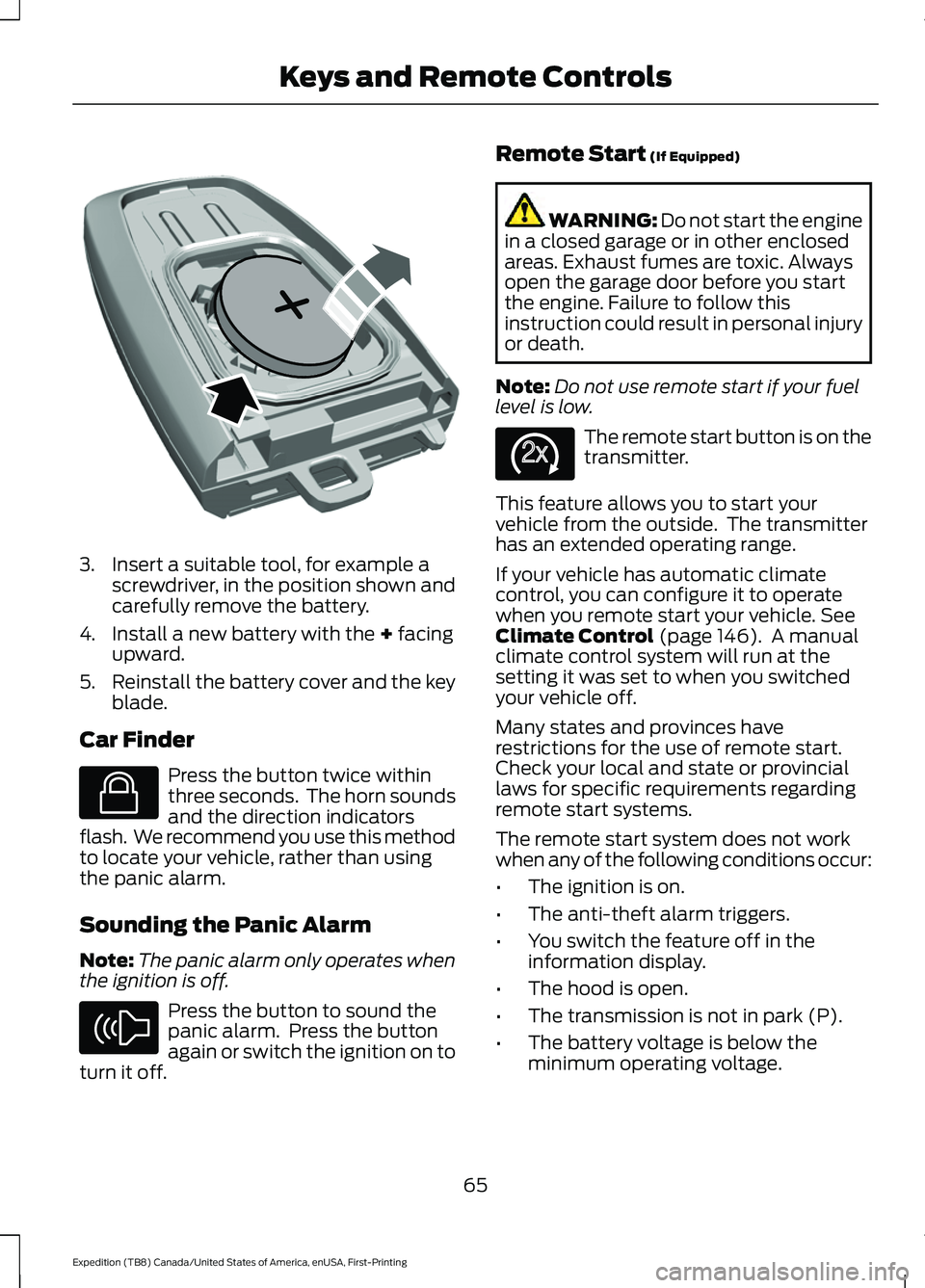
3. Insert a suitable tool, for example a
screwdriver, in the position shown and
carefully remove the battery.
4. Install a new battery with the + facing
upward.
5. Reinstall the battery cover and the key
blade.
Car Finder Press the button twice within
three seconds. The horn sounds
and the direction indicators
flash. We recommend you use this method
to locate your vehicle, rather than using
the panic alarm.
Sounding the Panic Alarm
Note: The panic alarm only operates when
the ignition is off. Press the button to sound the
panic alarm. Press the button
again or switch the ignition on to
turn it off. Remote Start
(If Equipped) WARNING: Do not start the engine
in a closed garage or in other enclosed
areas. Exhaust fumes are toxic. Always
open the garage door before you start
the engine. Failure to follow this
instruction could result in personal injury
or death.
Note: Do not use remote start if your fuel
level is low. The remote start button is on the
transmitter.
This feature allows you to start your
vehicle from the outside. The transmitter
has an extended operating range.
If your vehicle has automatic climate
control, you can configure it to operate
when you remote start your vehicle.
See
Climate Control (page 146). A manual
climate control system will run at the
setting it was set to when you switched
your vehicle off.
Many states and provinces have
restrictions for the use of remote start.
Check your local and state or provincial
laws for specific requirements regarding
remote start systems.
The remote start system does not work
when any of the following conditions occur:
• The ignition is on.
• The anti-theft alarm triggers.
• You switch the feature off in the
information display.
• The hood is open.
• The transmission is not in park (P).
• The battery voltage is below the
minimum operating voltage.
65
Expedition (TB8) Canada/United States of America, enUSA, First-Printing Keys and Remote ControlsE218402 E138623 E138624 E138625
Page 96 of 574
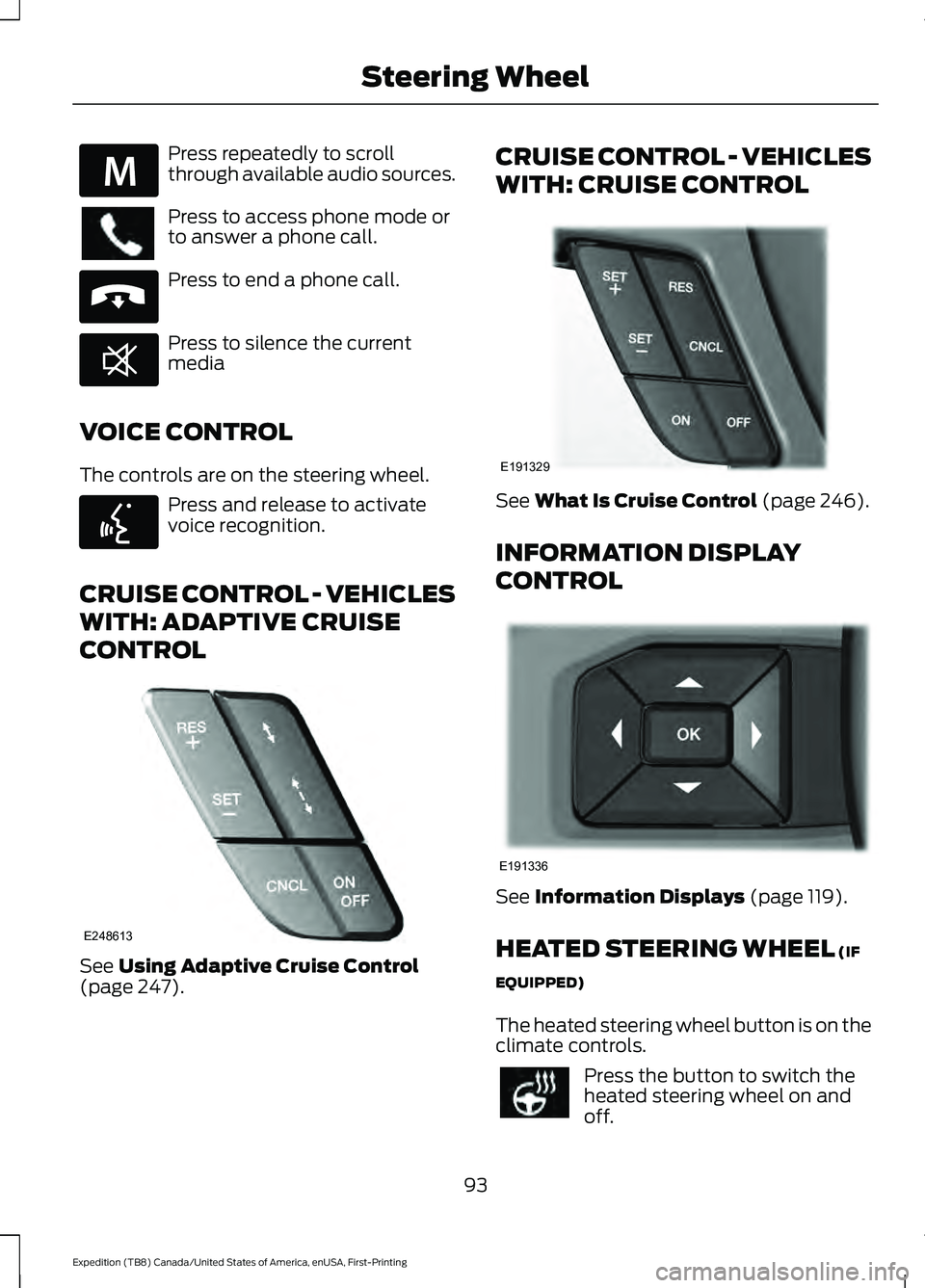
Press repeatedly to scroll
through available audio sources.
Press to access phone mode or
to answer a phone call.
Press to end a phone call.
Press to silence the current
media
VOICE CONTROL
The controls are on the steering wheel. Press and release to activate
voice recognition.
CRUISE CONTROL - VEHICLES
WITH: ADAPTIVE CRUISE
CONTROL See Using Adaptive Cruise Control
(page 247). CRUISE CONTROL - VEHICLES
WITH: CRUISE CONTROL
See
What Is Cruise Control (page 246).
INFORMATION DISPLAY
CONTROL See
Information Displays (page 119).
HEATED STEERING WHEEL
(IF
EQUIPPED)
The heated steering wheel button is on the
climate controls. Press the button to switch the
heated steering wheel on and
off.
93
Expedition (TB8) Canada/United States of America, enUSA, First-Printing Steering WheelE289636 E265040 E268549 E142599 E248613 E191329 E191336
Page 149 of 574
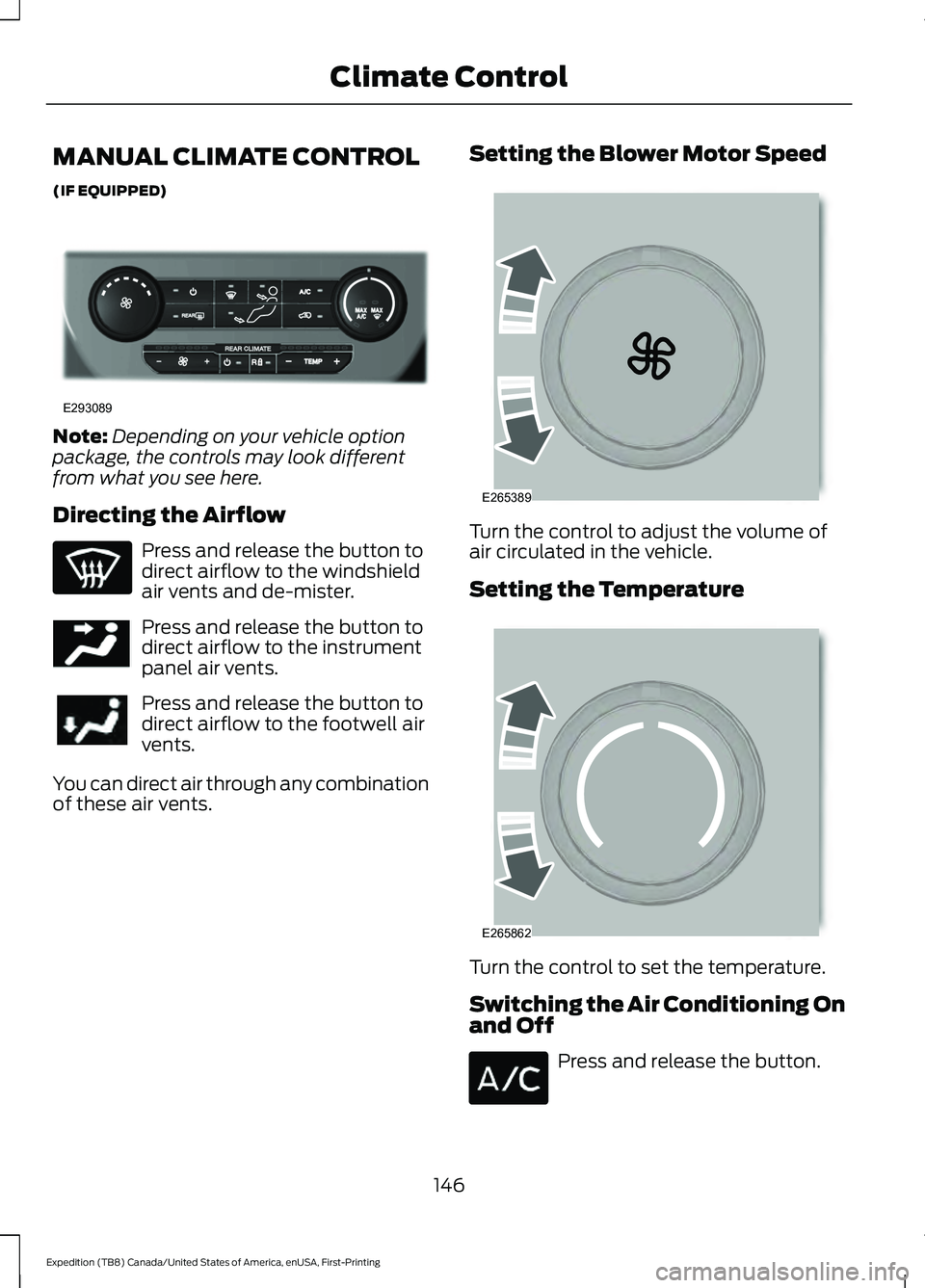
MANUAL CLIMATE CONTROL
(IF EQUIPPED)
Note:
Depending on your vehicle option
package, the controls may look different
from what you see here.
Directing the Airflow Press and release the button to
direct airflow to the windshield
air vents and de-mister.
Press and release the button to
direct airflow to the instrument
panel air vents.
Press and release the button to
direct airflow to the footwell air
vents.
You can direct air through any combination
of these air vents. Setting the Blower Motor Speed Turn the control to adjust the volume of
air circulated in the vehicle.
Setting the Temperature
Turn the control to set the temperature.
Switching the Air Conditioning On
and Off
Press and release the button.
146
Expedition (TB8) Canada/United States of America, enUSA, First-Printing Climate ControlE293089 E244097 E265389 E265862
Page 150 of 574
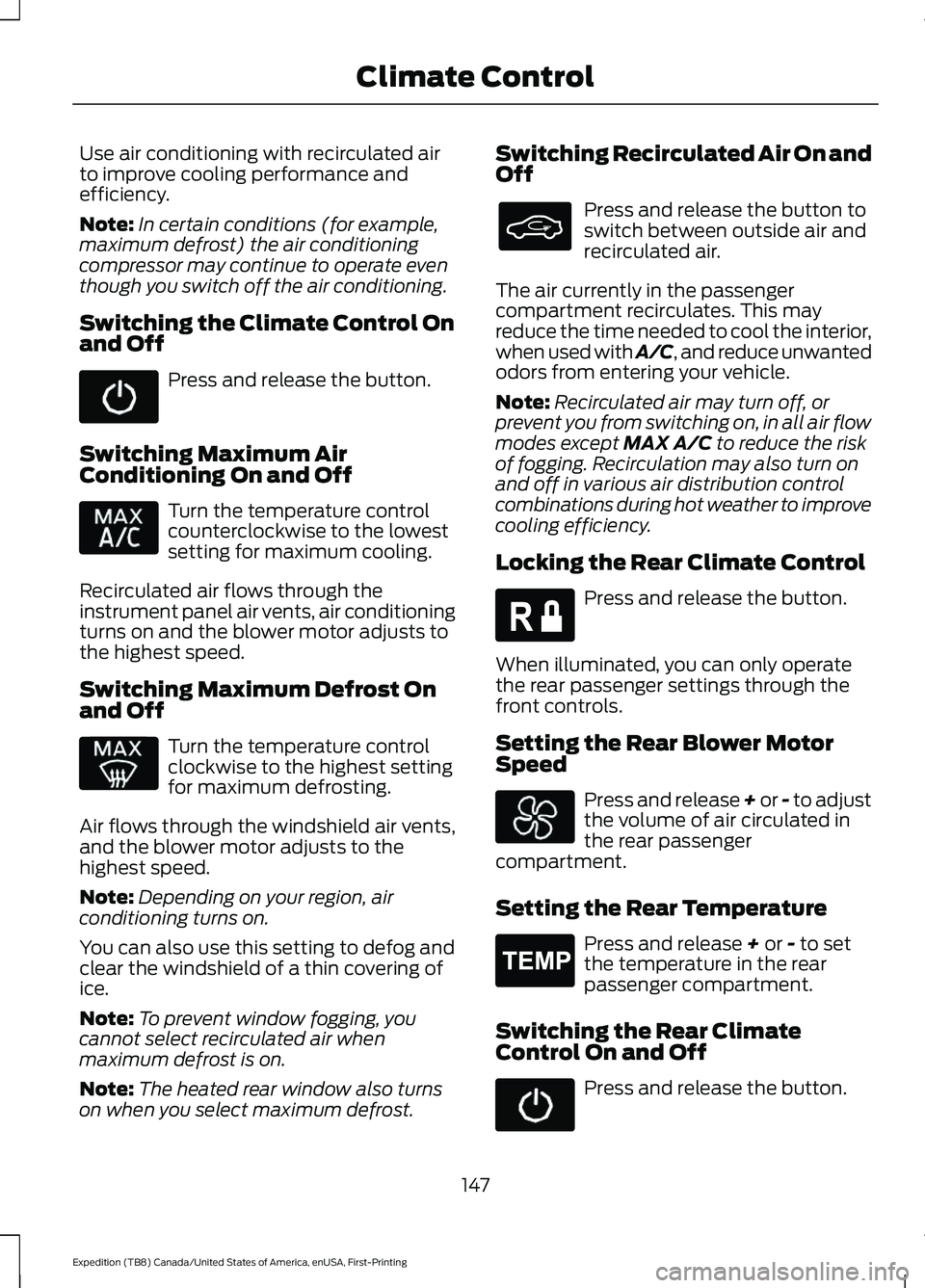
Use air conditioning with recirculated air
to improve cooling performance and
efficiency.
Note:
In certain conditions (for example,
maximum defrost) the air conditioning
compressor may continue to operate even
though you switch off the air conditioning.
Switching the Climate Control On
and Off Press and release the button.
Switching Maximum Air
Conditioning On and Off Turn the temperature control
counterclockwise to the lowest
setting for maximum cooling.
Recirculated air flows through the
instrument panel air vents, air conditioning
turns on and the blower motor adjusts to
the highest speed.
Switching Maximum Defrost On
and Off Turn the temperature control
clockwise to the highest setting
for maximum defrosting.
Air flows through the windshield air vents,
and the blower motor adjusts to the
highest speed.
Note: Depending on your region, air
conditioning turns on.
You can also use this setting to defog and
clear the windshield of a thin covering of
ice.
Note: To prevent window fogging, you
cannot select recirculated air when
maximum defrost is on.
Note: The heated rear window also turns
on when you select maximum defrost. Switching Recirculated Air On and
Off Press and release the button to
switch between outside air and
recirculated air.
The air currently in the passenger
compartment recirculates. This may
reduce the time needed to cool the interior,
when used with A/C, and reduce unwanted
odors from entering your vehicle.
Note: Recirculated air may turn off, or
prevent you from switching on, in all air flow
modes except MAX A/C to reduce the risk
of fogging. Recirculation may also turn on
and off in various air distribution control
combinations during hot weather to improve
cooling efficiency.
Locking the Rear Climate Control Press and release the button.
When illuminated, you can only operate
the rear passenger settings through the
front controls.
Setting the Rear Blower Motor
Speed Press and release + or - to adjust
the volume of air circulated in
the rear passenger
compartment.
Setting the Rear Temperature Press and release
+ or - to set
the temperature in the rear
passenger compartment.
Switching the Rear Climate
Control On and Off Press and release the button.
147
Expedition (TB8) Canada/United States of America, enUSA, First-Printing Climate Control E266664 E265400
Page 151 of 574
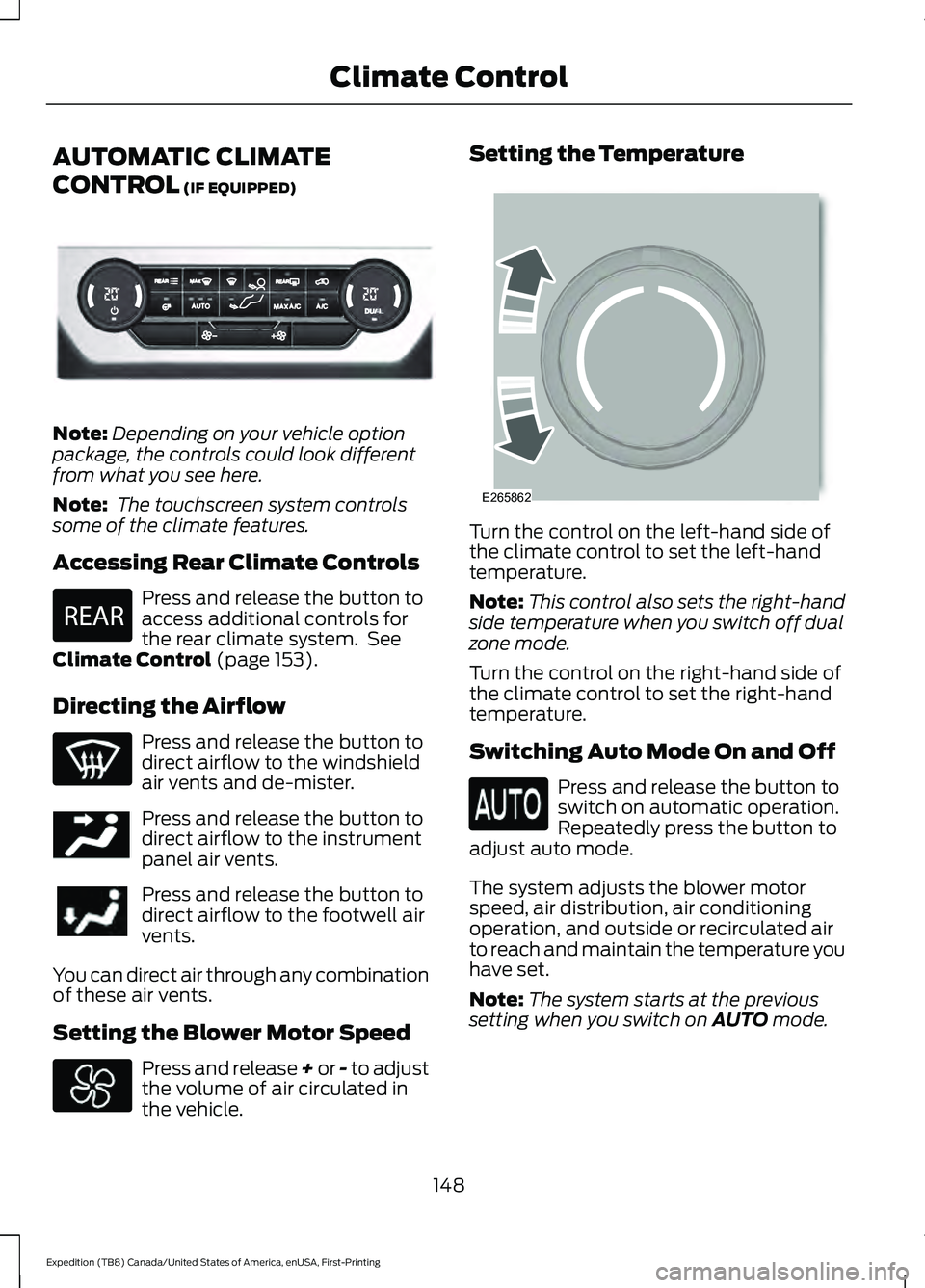
AUTOMATIC CLIMATE
CONTROL (IF EQUIPPED)
Note:
Depending on your vehicle option
package, the controls could look different
from what you see here.
Note: The touchscreen system controls
some of the climate features.
Accessing Rear Climate Controls Press and release the button to
access additional controls for
the rear climate system. See
Climate Control
(page 153).
Directing the Airflow Press and release the button to
direct airflow to the windshield
air vents and de-mister.
Press and release the button to
direct airflow to the instrument
panel air vents.
Press and release the button to
direct airflow to the footwell air
vents.
You can direct air through any combination
of these air vents.
Setting the Blower Motor Speed Press and release + or - to adjust
the volume of air circulated in
the vehicle. Setting the Temperature
Turn the control on the left-hand side of
the climate control to set the left-hand
temperature.
Note:
This control also sets the right-hand
side temperature when you switch off dual
zone mode.
Turn the control on the right-hand side of
the climate control to set the right-hand
temperature.
Switching Auto Mode On and Off Press and release the button to
switch on automatic operation.
Repeatedly press the button to
adjust auto mode.
The system adjusts the blower motor
speed, air distribution, air conditioning
operation, and outside or recirculated air
to reach and maintain the temperature you
have set.
Note: The system starts at the previous
setting when you switch on
AUTO mode.
148
Expedition (TB8) Canada/United States of America, enUSA, First-Printing Climate ControlE293315 E270447 E244097 E265862
Page 152 of 574
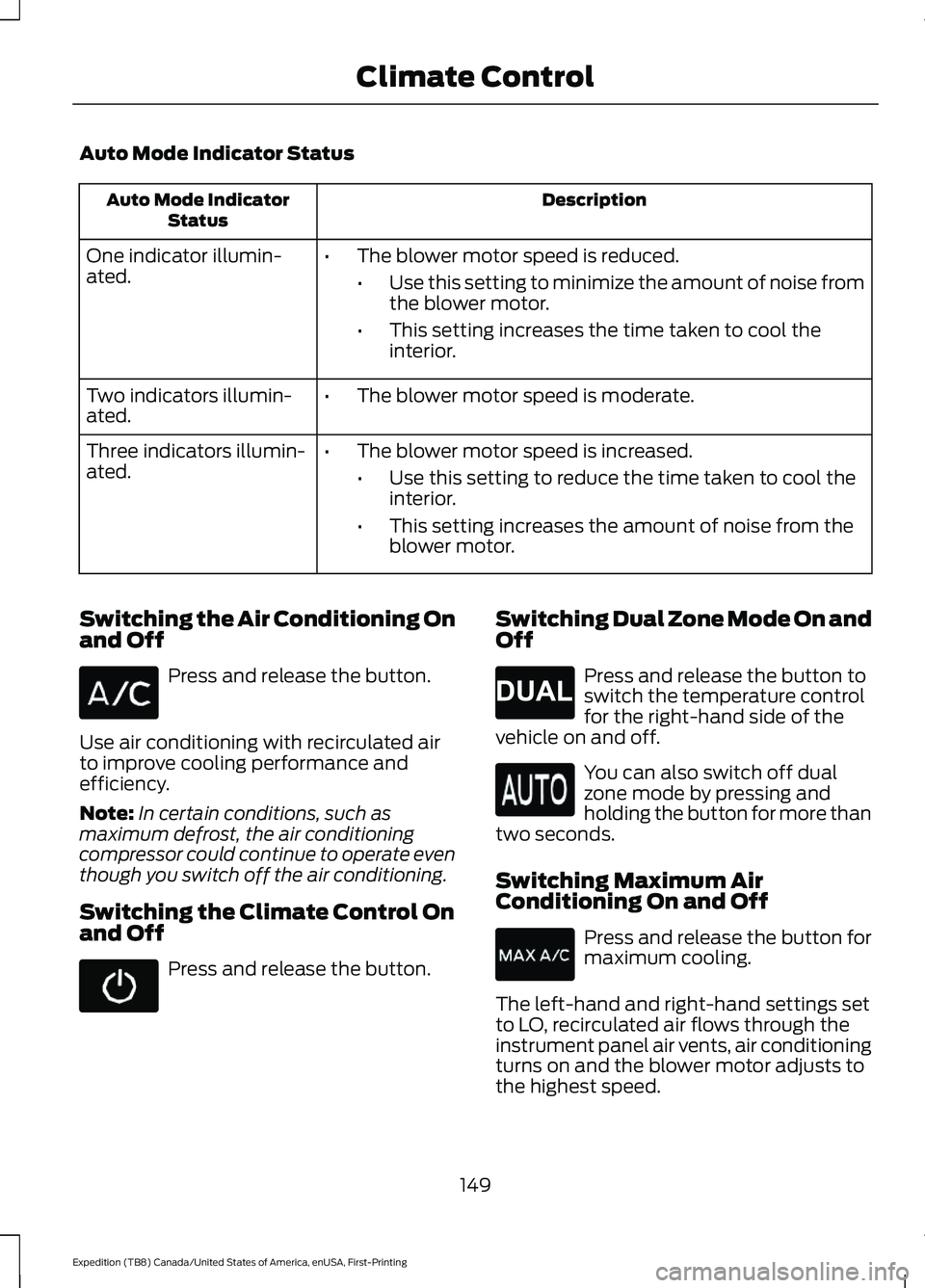
Auto Mode Indicator Status
Description
Auto Mode Indicator
Status
One indicator illumin-
ated. •
The blower motor speed is reduced.
•Use this setting to minimize the amount of noise from
the blower motor.
• This setting increases the time taken to cool the
interior.
Two indicators illumin-
ated. •
The blower motor speed is moderate.
Three indicators illumin-
ated. •
The blower motor speed is increased.
•Use this setting to reduce the time taken to cool the
interior.
• This setting increases the amount of noise from the
blower motor.
Switching the Air Conditioning On
and Off Press and release the button.
Use air conditioning with recirculated air
to improve cooling performance and
efficiency.
Note: In certain conditions, such as
maximum defrost, the air conditioning
compressor could continue to operate even
though you switch off the air conditioning.
Switching the Climate Control On
and Off Press and release the button. Switching Dual Zone Mode On and
Off Press and release the button to
switch the temperature control
for the right-hand side of the
vehicle on and off. You can also switch off dual
zone mode by pressing and
holding the button for more than
two seconds.
Switching Maximum Air
Conditioning On and Off Press and release the button for
maximum cooling.
The left-hand and right-hand settings set
to LO, recirculated air flows through the
instrument panel air vents, air conditioning
turns on and the blower motor adjusts to
the highest speed.
149
Expedition (TB8) Canada/United States of America, enUSA, First-Printing Climate Control E265280
Page 153 of 574
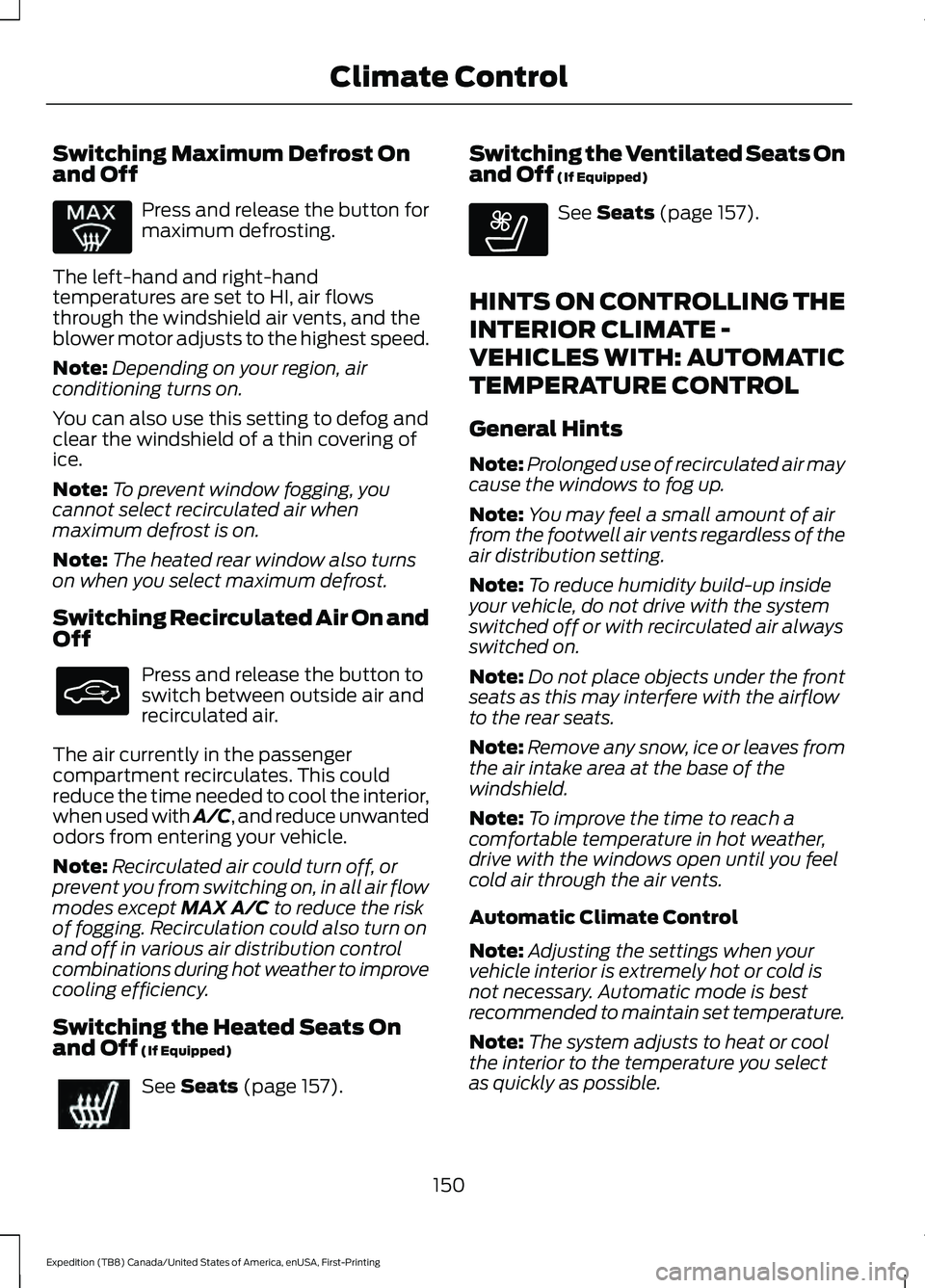
Switching Maximum Defrost On
and Off
Press and release the button for
maximum defrosting.
The left-hand and right-hand
temperatures are set to HI, air flows
through the windshield air vents, and the
blower motor adjusts to the highest speed.
Note: Depending on your region, air
conditioning turns on.
You can also use this setting to defog and
clear the windshield of a thin covering of
ice.
Note: To prevent window fogging, you
cannot select recirculated air when
maximum defrost is on.
Note: The heated rear window also turns
on when you select maximum defrost.
Switching Recirculated Air On and
Off Press and release the button to
switch between outside air and
recirculated air.
The air currently in the passenger
compartment recirculates. This could
reduce the time needed to cool the interior,
when used with A/C, and reduce unwanted
odors from entering your vehicle.
Note: Recirculated air could turn off, or
prevent you from switching on, in all air flow
modes except MAX A/C to reduce the risk
of fogging. Recirculation could also turn on
and off in various air distribution control
combinations during hot weather to improve
cooling efficiency.
Switching the Heated Seats On
and Off
(If Equipped) See
Seats (page 157). Switching the Ventilated Seats On
and Off
(If Equipped) See
Seats (page 157).
HINTS ON CONTROLLING THE
INTERIOR CLIMATE -
VEHICLES WITH: AUTOMATIC
TEMPERATURE CONTROL
General Hints
Note: Prolonged use of recirculated air may
cause the windows to fog up.
Note: You may feel a small amount of air
from the footwell air vents regardless of the
air distribution setting.
Note: To reduce humidity build-up inside
your vehicle, do not drive with the system
switched off or with recirculated air always
switched on.
Note: Do not place objects under the front
seats as this may interfere with the airflow
to the rear seats.
Note: Remove any snow, ice or leaves from
the air intake area at the base of the
windshield.
Note: To improve the time to reach a
comfortable temperature in hot weather,
drive with the windows open until you feel
cold air through the air vents.
Automatic Climate Control
Note: Adjusting the settings when your
vehicle interior is extremely hot or cold is
not necessary. Automatic mode is best
recommended to maintain set temperature.
Note: The system adjusts to heat or cool
the interior to the temperature you select
as quickly as possible.
150
Expedition (TB8) Canada/United States of America, enUSA, First-Printing Climate Control E268558